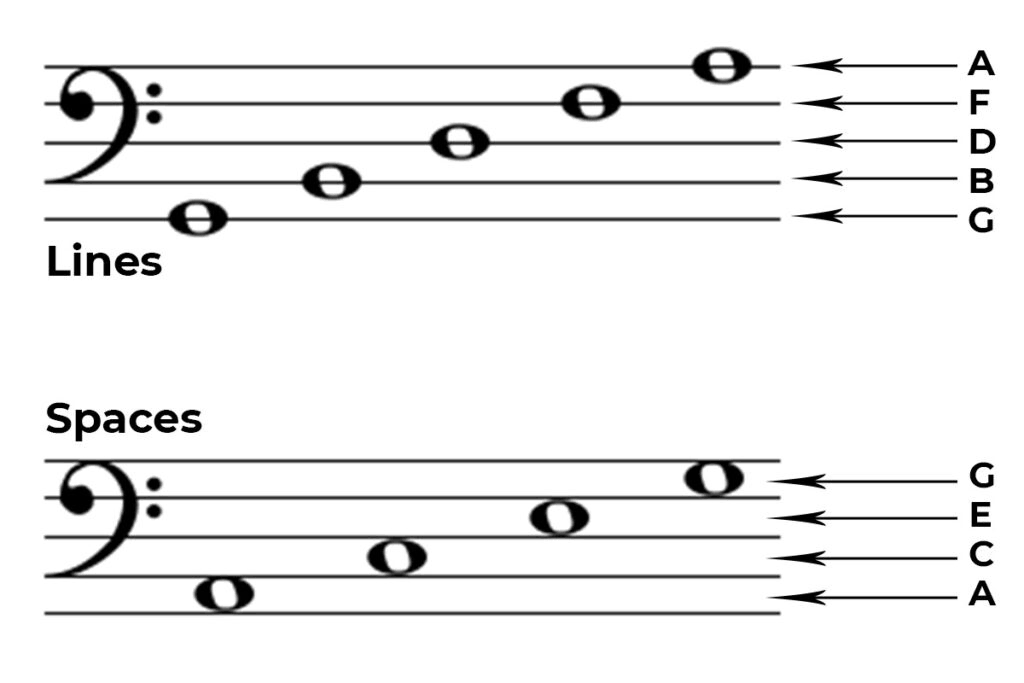The General Overview Of A Bass Clef

The Bass Clef
The bass clef is one of the most important symbols used in staff music notation to make writing and reading of music easy for musicians.
Basically, to learn about staff music notation, and develop our ability to write and read staff music properly, learning about musical clef is really important.
Primarily, staff music is built on five horizontal lines and five spaces known as the music staff (or stave) to define the notes’ name and their pitch. Clef is placed on the musical staff to establish the names of each line and space. It also helps us to know which note to play and how high or low the note is.
The bass clef and the treble clef are the two major clefs that are commonly used in staff music notation.
Actually, we still have other types of clefs like C clefs and Percussion clefs. But both treble and bass clefs are the most popular clefs that we have and they form the basis of the grand staff.
Specifically, the treble clef is for high-pitched music while the bass is used for lower-pitched music.
Our focus in this article is on the bass clef and we will definitely discuss what the bass clef is. Moreover, we will look into bass clef notes and see where each note stands on the bass clef.
We will also discuss how to draw a bass clef.
Without any further ado let go straight to our discussion about bass clef and let us start with what the clef is.
What Is A Clef In Music?
Clefs are the curly shape symbol at the beginning of the staff lines that establish the name of each line and space of the staff.
We have discussed all the different types of clefs in The Musical Clefs article and you can check it out.
Actually, the Staff lines and spaces work together along with the clefs to tell us how high or low the notes we want to play are.
Specifically, the high and low notes on the staff indicate the high and low pitch respectively. However, clef further helps us to redefine the pitch of the note.
With proper clef, we can say all notes on a specific clef are higher or lower than the notes on another clef. For instance, notes on the treble clef are higher in pitch than notes on the bass clef.
Since we have an idea of what the clef is and can do in staff music notation let us look into bass clef.
What is the Bass Clef?

The bass clef is a symbol in musical notation that is basically used to indicate that the fourth line from the bottom of the stave is the F below the middle C.
The bass clef is used to establish the fourth line from the bottom of the stave as the F below the middle.
On the staff, the bass clef symbol curls around the staff and makes dots around the fourth staff line (F line) from the bottom.
This fixed the fourth line of the staff as F. Specifically, the fourth line is note F3 which lies below the middle C.
The bass clef in this case shows us the lower-sounding notes. Majorly, notes below the middle C. However, in some cases with the aid of the ledger lines, it can notate middle C and notes above it.
How To Draw A Bass Clef?

Drawing the bass clef is not something hard but we must know what to do. It is very simple to draw compared to drawing a treble clef. the bass clef is not something hard but we must know what to do.
In the Quick Guide On How to Draw A Bass Clef post, we discussed drawing the bass clef in detail. Also, we provide material that can help us practice drawing a bass clef and mastering it.
Notwithstanding, this post will also take us through how we can easily draw the F clef in simple four steps.
Step one: We will start the drawing on the fourth line from the bottom with a big dot.
Step two: we will then make a curved shape that looks like a question mark. So we will start from the dot we make on the fourth line and make a curve like a small arc of a circle between the fifth and the fourth line.
Step three: Here we will make a curve down the first line
Step four: This is the final step. We will draw a dot on both spaces that is above and below the fourth line of the staff.
What Instruments Use The Bass Clef?
There are different instruments that read their notes from the bass clef.
Besides the musical instrument, the F clef is normally used for lowered-pitched voices.
Specifically, it is used for bass voice in choral music scores as well as organ pedal notes.
Moreover, the bass clef is used for lower-pitched instruments like the trombone, tuba, cello, bassoon, and double bass.
The bass clef is also used along with the treble clef for the grand staff to write music for multi-pitched instruments like piano or organ.
The Bass Clef Notes

The bass clef notes correspond to the alphabetical names of lines and spaces in the bass staff.
Remember that the clef is the first musical symbol at the beginning of every music staff.
Clef is indeed important because it establishes the pitch of the staff and lets us know the name of the note on each line or space of the staff.
Of course, the lines and spaces of the F clef have names just like the Treble clef. These names are derived from the same musical alphabet A-B-C-D-E-F-G.
As shown in the diagram above, the Bass staff consists of five horizontal (parallel) lines and four spaces.
The lines and spaces of the clef have names and are counted upwards as 1-2-3-4-5 for the lines and 1-2-3-4 for the spaces.
So, from the bottom of the staff lines, the letter names of the line in the Bass clef are G-B-D-F-A.
Specifically, the first line is G, the second line is B, the third line is D, the fourth line is F, and the fifth line is A.
Likewise, the spaces are also reckoned from the bottom to the top as indicated in the diagram above.
So, from the bottom to the top, the letter names of the spaces in the F clef are A-C-E-G.
Particularly, the first space is A, the second space is C, the third space is E, and the fifth space is G.
Mnemonics for F Clef Notes

The mnemonics help beginners to identify each note on the staff with a clef faster. So to remember the letter names of the lines on the Bass staff easily words are formed from the letter G-B-D-F-A.
The word is known as mnemonics (memory aids) and is “GOOD BOYS DESERVE FOOD ALWAYS”.
This means GOOD is formed from G, BOYS from B, DESERVE from D, FAVOUR from F, and ALWAYS from A.
The Same goes for the spaces on the Bass staff. As we have already known, the letter names of the spaces in Bass clef are A – C – E – G.
The mnemonics (memory aids) formed from the letters are “ALL COWS EAT GRASS”.
This means ALL is formed from the A, CATTLE from C, EAT from E, and GRASS from G.
Note that you can also make up your own mnemonics for easy recognition of all the notes or pitches on F clef.
Notice On Using Mnemonics
Note that using mnemonics is a great tool for beginners to learn and remember all the notes on the F clef.
However, it is not the best and long-term way to learn the reading of the note on the staff notation.
If we are serious about reading the staff music, committing the name of each line and space to memory directly is the best.
Besides, the much better way to learn the notes on the staff is a relative or positional technique along with a drill.
Ledger Lines Of The Bass Staff

A ledger line is a short line added below or above the regular musical staff in musical notation. We basically use the ledger line to notate musical notes with the pitch above or below the regular musical staff.
A ledger line is a little line above the bass clef on which the middle C is written. You can see it clearly in the example we have in the diagram above.
Leger lines are used whenever the note is too high or too low to be written on the bass staff. That is the general function of a ledger line in staff music notation as said earlier.
Note that as many ledger lines can be used as are required on the staff. For instance, several notes of the staff can be continued above or below the bass staff.
In this case, we employ ledger lines to write those notes as shown in the example above.
Reading those notes on the ledger lines above or below the Bass staff can be discouraging because they look intimidating. But we do not need to worry because we will learn how to read them in the next session.
What Are The Ledger Lines For F Clef?
Now let us discuss the name of the pitches or notes we have in the ledger lines above and below the Bass staff.
The example in the diagram above shows notes on the ledger line above the Bass staff. So what is the name of the notes on those ledger lines?
The simple logic here is that our musical alphabets go from the first alphabet to the last. Then starts again from the first alphabet which is now at the higher pitch.
This is a continuous process across the staff, the notes alphabets keep repeating themselves.
How to Read The Upper Ledger Lines on F Clef?

So, from the first staff line up to the last ledger line above the staff, we have A – B – C – D – E – F – G – A – B – C’, and so on. Remember that C’ is the middle C which is basically C4.
As we can see, the note has extended the Bass staff but continues with the help of ledger lines.
Typically, the upper line of the Bass staff (the fifth line from the bottom) is A. The space above it will be B since the music alphabet continues and is repetitive.
To have the note above the fifth line we will use a ledger line as we have it in the diagram. So the alphabetical name of the note on the first ledger line above the Bass staff is C.
That C is basically the middle C as we have it on the grand staff. The middle C is common to both the treble clef and the bass clef and that is the essence of the middle C in staff music.
The note in the space above the ledger line used for middle C is D. So the note on the second ledger line after the middle C is E (after the space with pitch or note B).
That is how the trend continues and matches with the treble clef as we have it in the great staff.
How to Read The Lower Ledger Lines on G Clef?

The music alphabet on the lower ledger lines of the Bass clef is going from the last note (G) to the first note (A). Then it will start again from the last note (G) which is now lower and continue in the same loop.
Therefore, from note G on the first line of the Bass staff, we will have G – F – E – D – C – B – A – G, and so on in descending order.
The musical notes keep going after we have exceeded the main staff and the ledger lines make it possible.
Typically, the bottom line of the Bass staff (the first line from the bottom) is G. So, the space below the bottom line will be F since the music alphabet continues and is repetitive in reverse order.
To have the notes below the bottom line of the F clef, we will use ledger lines. The typical example is what we have in the diagram above.
Position of Each Note in The Bass Clef
Every note on the bass staff is located in a fixed position either in space or on a line. This is possible because the Bass Clef symbol has fixed a line and established it as F.
Basically, to read the musical notes on the bass clef, we simply begin our reading with the F line. So from the F line, we can read the notes upward or downward through the alphabet.
In particular, each line and space on the bass staff is assigned a specific note. The position of each note has been discussed in The Bass Clef Notes section above.
In this section, we want to look at different positions that a specific note can be found in the bass clef.
Where is A on bass clef?

Note A is located on the first space at the bottom of the bass clef. This A in reference to the middle C is known as A2.
The other A can be found on the fifth line which is the topmost line of the staff. The A on the top line of the staff is known as A3.
Where is B on bass clef?

Note B is located on the second line from the bottom of the bass clef. That B is known as B2.
The other B can be found on the space directly above the fifth line which is the space above the staff.
The B in that position is known as B3 and is directly below the middle C (that is C4).
Where is C on bass clef?

Note C is located on the second space from the bottom of the bass staff. That C is C3.
The other C to that is the middle C which can be found on the first ledger line above the staff. The middle C is the C4.
Where is D on bass clef?

Note D is located on the third line from the bottom on the Bass Staff. This D is known as D3.
The other D can be found directly above the middle C or below the first ledger line below the Bass staff.
The one above the middle C is C4 while the one below the staff first ledger line below the Bass staff is D2.
Where is E on bass clef?

Note E can be found on the third space of the Bass staff when we count from the bottom to the top of the staff. This particular E is known as E3.
The other E can be found on the first ledger line below the Bass staff as E2.
The other E which is E4 is located on the second ledger line above the Bass staff lines.
Where is F on bass clef?

Note F is the note name of the fourth line of the Bass staff. This line defines the clef and the F on it is F3.
The other F can be found in the space directly below the staff. That F is known as F2.
Another F can be found with the aid of a ledger line above the staff lines. That F will be on top of the second ledger line above the bass staff and is known as F4.
Where is G on bass clef?

Note G is located on the fourth space at the top of the bass staff. This G in reference to the middle C is known as G3.
Another G can be found on the first line from the bottom of the staff. This particular G is known as G2.
Final Thought
You might have learned about the clefs and the notes of the staff before and still not understand the Bass clef properly.
We hope with this guide you will have a proper understanding of how music notation works on Bass clef.
We believe the post is self-explanatory and that you will find it helpful to learn one to two things about the Bass clef.
However, if you have any questions related to the Bass clef, kindly ask in the comment section below.
At Phamox Music, we go all out for exactness and honesty. For this purpose, if by any means you found any possible glitch, be it factual, editorial or something that we need to update, kindly contact us.
If you find the information provided in this post Bass Clef interesting and helpful, kindly share it with someone you know that might need it.







